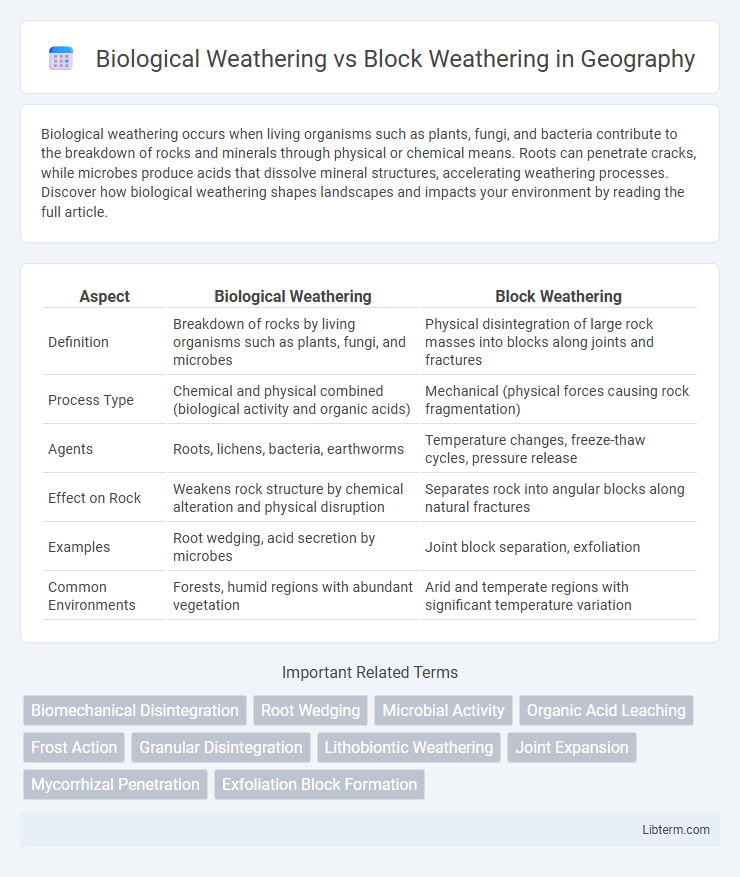Biological weathering occurs when living organisms such as plants, fungi, and bacteria contribute to the breakdown of rocks and minerals through physical or chemical means. Roots can penetrate cracks, while microbes produce acids that dissolve mineral structures, accelerating weathering processes. Discover how biological weathering shapes landscapes and impacts your environment by reading the full article.
Table of Comparison
| Aspect | Biological Weathering | Block Weathering |
|---|---|---|
| Definition | Breakdown of rocks by living organisms such as plants, fungi, and microbes | Physical disintegration of large rock masses into blocks along joints and fractures |
| Process Type | Chemical and physical combined (biological activity and organic acids) | Mechanical (physical forces causing rock fragmentation) |
| Agents | Roots, lichens, bacteria, earthworms | Temperature changes, freeze-thaw cycles, pressure release |
| Effect on Rock | Weakens rock structure by chemical alteration and physical disruption | Separates rock into angular blocks along natural fractures |
| Examples | Root wedging, acid secretion by microbes | Joint block separation, exfoliation |
| Common Environments | Forests, humid regions with abundant vegetation | Arid and temperate regions with significant temperature variation |
Introduction to Weathering Processes
Biological weathering involves the breakdown of rocks through the actions of living organisms such as plant roots, fungi, and microbes, promoting chemical and physical changes. Block weathering primarily refers to the disintegration of large rock masses into smaller blocks due to physical processes like temperature fluctuations and freeze-thaw cycles. Both processes play crucial roles in the overall landscape evolution by contributing to soil formation and sediment generation.
Defining Biological Weathering
Biological weathering is the process by which living organisms such as plants, fungi, and microbes contribute to the breakdown of rocks and minerals through physical disruption and chemical alteration. This form of weathering involves root growth expanding cracks, organic acids dissolving minerals, and microbial activity accelerating mineral decomposition. Unlike block weathering, which refers to the fracturing and detachment of large rock masses due to physical stresses, biological weathering specifically emphasizes the role of biotic factors in rock disintegration.
Understanding Block Weathering
Block weathering occurs when large, coherent masses of rock break down into smaller blocks primarily due to physical and mechanical processes such as freeze-thaw cycles, thermal expansion, and pressure release. Unlike biological weathering, which involves chemical alteration by organisms or organic acids, block weathering mainly results from physical stresses that exploit rock jointing and fractures. Understanding block weathering is essential for assessing rock stability in engineering projects and landscape evolution in geomorphology.
Key Agents of Biological Weathering
Key agents of biological weathering include plant roots, fungi, bacteria, and lichens that break down rock through physical disruption and chemical alteration. These organisms secrete organic acids and enzymes that dissolve mineral components, accelerating rock decomposition. In contrast, block weathering primarily involves physical processes like freeze-thaw cycles that cause rock fragmentation without significant chemical changes.
Mechanisms Involved in Block Weathering
Block weathering involves the mechanical breakdown of rock into large, angular blocks primarily through processes such as freeze-thaw cycles, thermal expansion, and exfoliation. Water enters cracks and pores within the rock, freezing and expanding to exert pressure that causes fracturing. Unlike biological weathering, which relies on organic activity such as root growth or microbial action, block weathering is dominated by physical forces that exploit existing weaknesses in rock structures.
Differences Between Biological and Block Weathering
Biological weathering involves the breakdown of rocks through the actions of living organisms such as plants, fungi, and bacteria, which produce acids or physically disrupt rock structures. Block weathering, also known as joint-block weathering, refers to the fragmentation of rock masses along pre-existing joints or fractures without chemical alteration. Key differences between biological and block weathering include the mechanisms involved--biological weathering is chemical and physical through biotic activity, while block weathering is primarily physical, driven by stress release and freeze-thaw cycles causing rock disintegration along joints.
Environmental Conditions Favoring Each Type
Biological weathering thrives in warm, moist environments rich in organic activity, where plant roots, fungi, and microbial action accelerate rock disintegration. Block weathering predominantly occurs in arid or semi-arid climates with significant temperature fluctuations, causing physical stress that fractures rocks into large, angular blocks. Soil presence and vegetation density distinctly influence biological weathering, while block weathering depends largely on mechanical breakdown due to thermal expansion and contraction.
Examples of Biological and Block Weathering
Biological weathering involves organisms like tree roots breaking rock apart, as seen in roots expanding in cracks or lichens producing acids that dissolve minerals. Block weathering refers to the fracturing and disintegration of large rock masses into blocks due to physical processes such as freeze-thaw cycles causing expansion and contraction along joints. Examples of block weathering include granite outcrops breaking into cubic blocks, while biological weathering is exemplified by burrowing animals and microbial activity accelerating rock decay.
Geological Significance of Both Weathering Types
Biological weathering accelerates rock disintegration through root growth, microbial activity, and organic acid production, significantly contributing to soil formation and nutrient cycling in ecosystems. Block weathering causes the mechanical breakdown of large rock masses into smaller blocks along joints and fractures, playing a crucial role in landscape evolution and sediment supply for downstream environments. Both weathering types are fundamental in shaping earth's surface morphology and influencing geological processes such as erosion, sedimentation, and mineral exposure.
Conclusion: Impacts on Landscape Evolution
Biological weathering accelerates rock decomposition through organic acids and root growth, significantly shaping soil formation and enhancing nutrient cycling. Block weathering, driven by physical stress such as temperature fluctuations and freeze-thaw cycles, leads to large rock fragment detachment influencing slope stability and sediment supply. The interplay of these processes dictates landscape evolution by controlling erosion rates, sediment transport, and terrain morphology over geological timescales.
Biological Weathering Infographic

 libterm.com
libterm.com